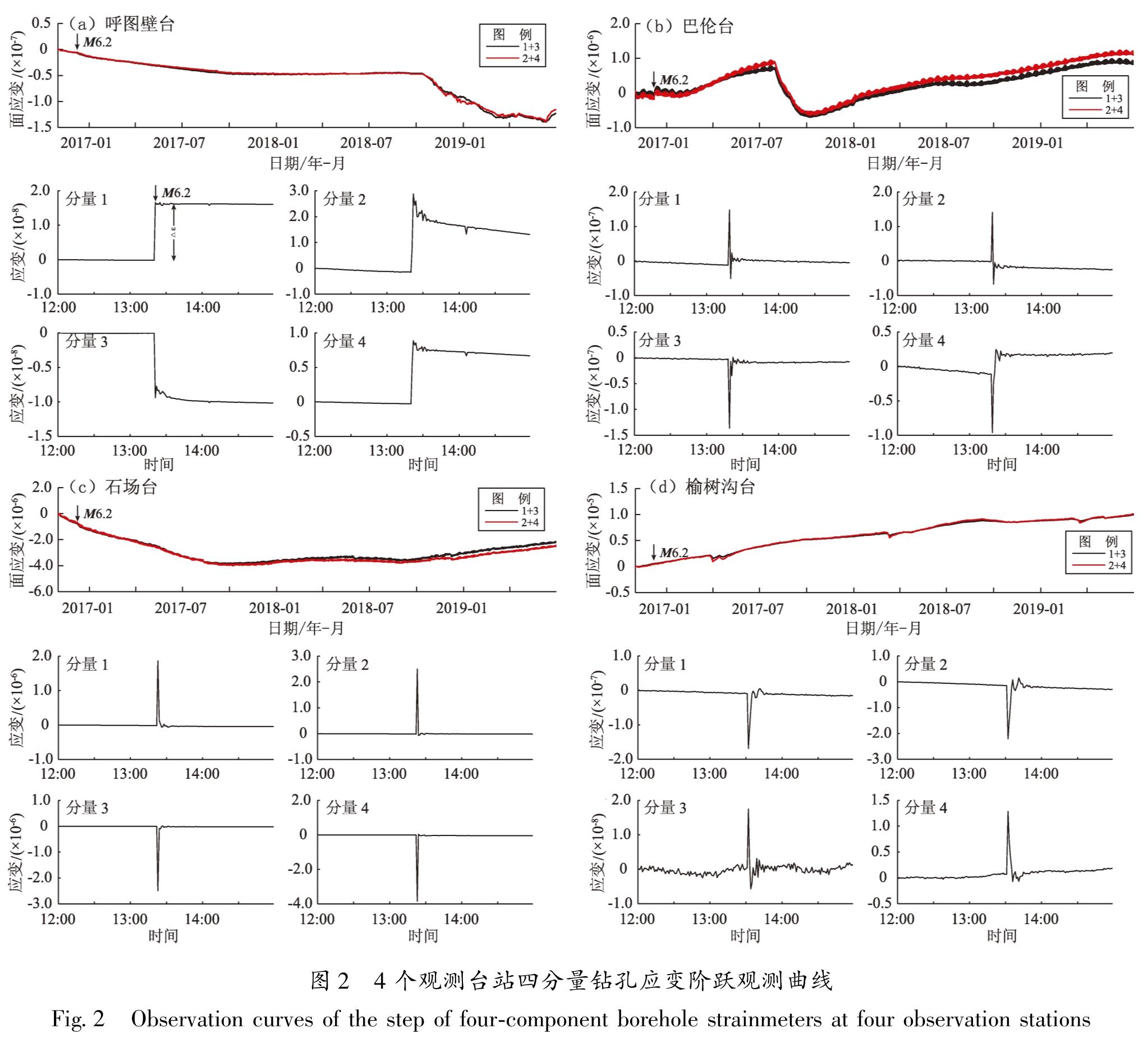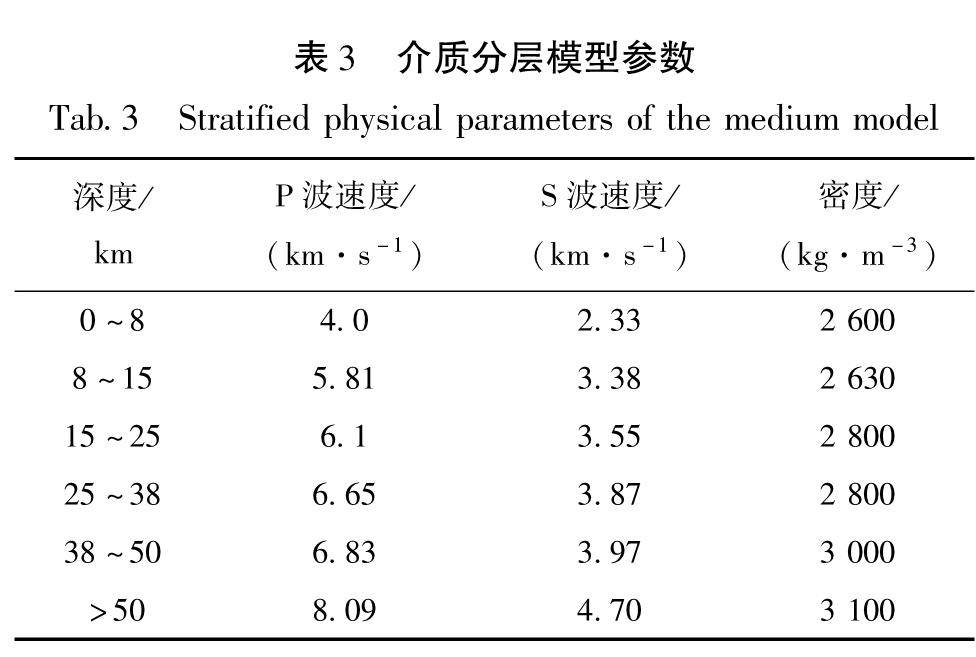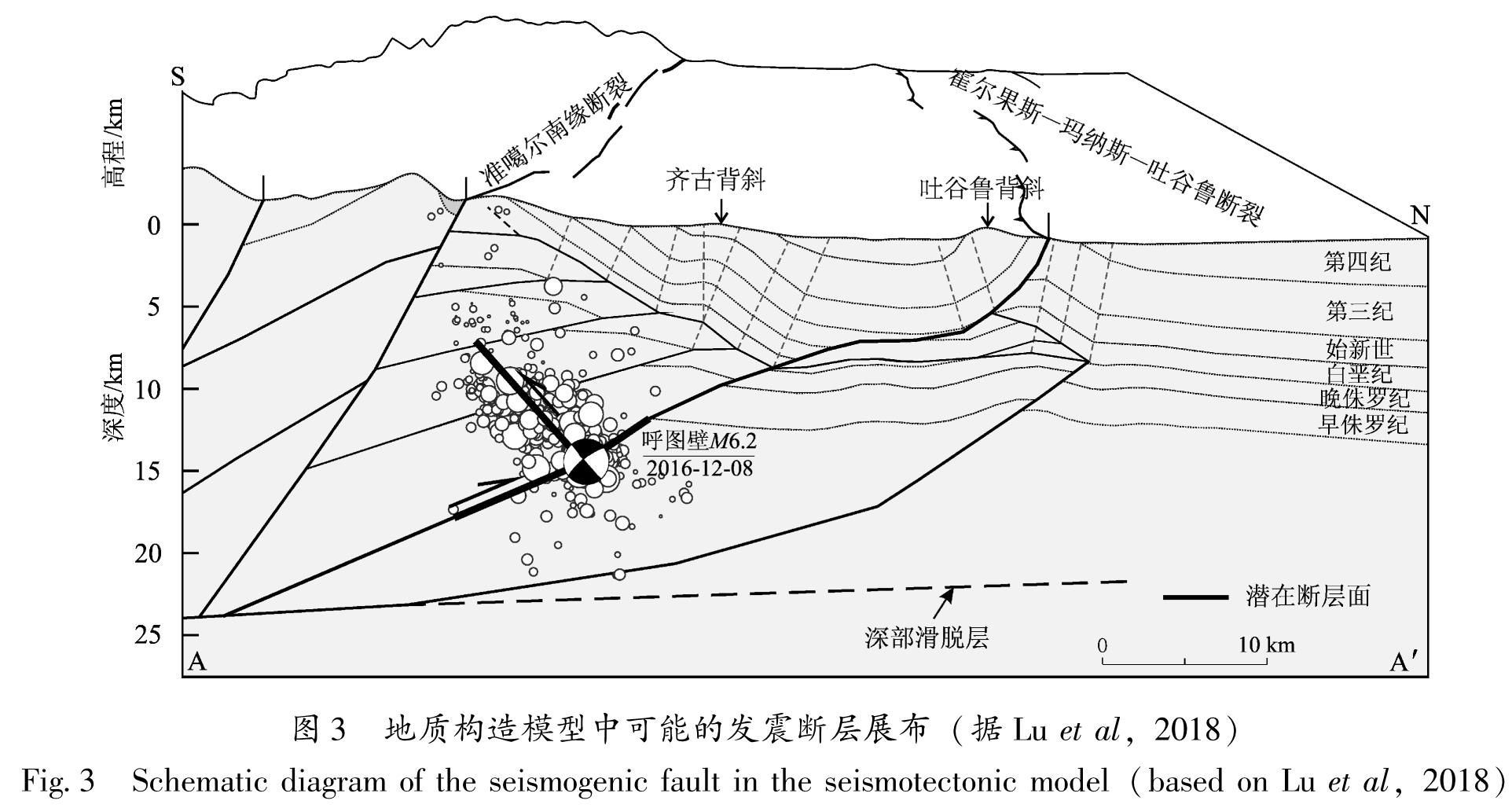基金项目:国家自然科学基金(41574081,41874116)和中央公益性科研院所基本科研业务专项(ZDJ2019-16,ZDJ2016-21)联合资助.
(应急管理部国家自然灾害防治研究院,北京 100085)
(National Institute of Natural Hazards,Ministry of Emergency Management of China,Beijing 100085,China)
Hutubi M6.2 earthquake; borehole strain observation; coseismic strain step; coseismic stress field; elastic dislocation theory
备注
基金项目:国家自然科学基金(41574081,41874116)和中央公益性科研院所基本科研业务专项(ZDJ2019-16,ZDJ2016-21)联合资助.
利用北天山地区的钻孔应变观测资料,分析2016年呼图壁M6.2地震同震应变阶跃的张、压性特征。结合余震精定位方法等给出的震源参数,基于弹性位错理论,模拟不同震源参数下的同震应变阶跃的张、压性特征。通过对钻孔应变张、压性的模拟值与实测值进行对比分析,研究呼图壁M6.2地震的发震断层。结果 表明:① 震中附近4个四分量钻孔应变台站数据自检性能较好,且多记录到明显的同震应变阶跃,其中,呼图壁、石场、巴伦台应变阶跃较为明显,张、压性变化最大值分别达2.5×10-8和-3.4×10-8; ② 在地震震源参数为293°/64°/90°(走向/倾角/滑动角)、发震断层面倾向北时,钻孔应变张、压性的模拟值与实测值最为吻合,呼图壁M6.2地震的发震断层极有可能为一条倾向北的高角度逆冲型盲断层。本文结果为认识呼图壁M6.2地震的发震构造提供重要力学依据。
In this paper,using the borehole strain observation data in the northern Tien Shan area,we analyzed the tensile-compressive characteristics of the coseismic strain step associated with the Hutubi M6.2 earthquake.Based on different source parameters by aftershock relocation etc.,we simulated the tensile-compressive characteristics of the coseismic strain step by the elastic dislocation theory.Through comparing the tensile-compressive characteristics between the modeled and the observed results,we analyzed the seismogenic fault of the Hutubi M6.2 earthquake.The results show that:① The data of the four four-component borehole strain observation stations near the epicenter have the good self-checking performance,which also record the coseismic strain steps successfully.Among them,the strain steps at Hutubi,Shichang and Baluntai stations are more obvious,and the maximum values of the tension and compression of the coseismic strain steps are 2.5×10-8 and-3.4×10-8,respectively.② When the seismic source parameters are 293 ° /64 ° /90 °(strike /dip /rake)and the fault plane inclines to the north,the simulated values of strain tension and compression of borehole are fit well with the measured values,therefore we induced that the Hutubi M6.2 earthquake most likely occurred on a north-trending high-angle blind thrust fault.The results provide an important mechanical basis for understanding the seismotectonics of the 2016 Hutubi M6.2 earthquake.
引言
2016年12月8日呼图壁M6.2地震发生在北天山前陆盆地的褶皱逆断层带上,其发震构造对于理解天山构造带变形模式至关重要。由于受到近场观测资料较少及发震构造复杂性的限制(Lu et al,2018; Yang et al,2019),尽管地震发生已超过3年,对于此次地震的发震断层仍存在争议,存在断层面为向南倾斜的低角度逆冲断层和向北倾斜的高角度反冲断层两种认识(Liu et al,2017; Lu et al,2018; Wang et al,2019; 刘建明等,2018; 徐志国等,2019; 杨文等,2018)。
地震的发生会引起断层附近应力场扰动,表现为形变观测资料的同震变化(Nykolaishen et al,2015; Vigny et al,2005)。钻孔应变观测记录到丰富的同震形变信息,为研究同震应力应变阶跃的张、压性特征提供基础资料(Asai et al,2005; Gladwin et al,1994; Johnston et al,2006; Qiu et al,2013)。邱泽华和石耀霖(2003)基于昌平台钻孔四分量应变观测资料,分析了2次张北地震引起的同震应变阶跃,并估算相应的应力阶跃; Barbour 等(2015)利用板块边界计划在南加州地区9个钻孔应变观测点资料,分析不同震级、不同震中距的地震所引起的同震阶变特征; 基于北天山地区的钻孔应变观测资料,Gong 等(2019)分析呼图壁M6.2地震的同震应变特征及其对北天山地区构造变形模式的指示。上述研究丰富了人们对同震应变阶跃张、压性特征的认识,同时也为研究发震断层的几何特征提供了重要约束。
本文利用北天山地区新建的4个钻孔应变观测台资料,分析呼图壁M6.2地震同震应变阶跃的张、压性特征; 结合余震精定位方法等给出的震源参数,基于弹性位错理论(Okada,1985),模拟不同震源参数下地震发生所引起的同震应力应变场变化。通过对钻孔应变张、压性的模拟值与实测值进行对比分析,研究呼图壁M6.2地震的发震断层。
1 区域地质构造背景
作为亚洲大陆内部最大的造山带之一,天山构造带由多期板块俯冲和碰撞作用形成(Charvet et al,2011; Xiao et al,2004; 陈科等,2014)。新生代以来,受欧亚板块与印度板块持续碰撞的影响,天山构造带经历了强烈的缩短和隆升作用(Allen et al,1999; Molnar,Tapponnier,1975)。深地震反射剖面揭示北天山山前地壳的薄皮构造特征,表现为由南向北依次发育有齐古逆断裂-褶皱带、霍尔果斯—玛纳斯—吐谷鲁活动逆断裂-褶皱带和独山子—哈拉安德—安集海活动逆断裂-褶皱带(Gong et al,2019; 杨晓平等,2012; 张培震等,1994)。这些逆断裂-褶皱带第四纪以来具有强烈的活动性,控制着区域内频繁的中强地震活动(Avouac et al,1993; Wang et al,2004)。
2016年呼图壁M6.2地震发生在天山前陆盆地的褶皱逆断裂带上,该区域吸收约50%印度板块与欧亚板块碰撞的缩短量(Yang et al,2019; Yin et al,1998; Zubovich et al,2010)。人工地震反射剖面认为,呼图壁M6.2地震的发震断层可能与霍尔果斯—玛纳斯—呼图壁断裂相关(Lu et al,2018),主震的发震断层倾向南(杨文等,2018); 而余震精定位结果显示,该地震可能为齐古背斜以南隐伏逆冲断坡的1条北倾的反冲断层,与1906年玛纳斯地震主滑动面呈“y”型分布(Lu et al,2018),是天山向准噶尔盆地扩展的应力作用下发生的1次“褶皱型”地震(刘建明等,2018)。
2 钻孔同震应变阶跃特征
三十多年的发展和实践证明,RZB型四分量钻孔应变仪实现了观测自洽,观测数据质量精度较高,精度达10-10,能够精确记录到地震导致的动、静态应变(欧阳祖熙等,2004; 邱泽华,石耀霖,2003)。为更好地监测北天山地区现今地壳运动特征,自2015年开始,中国地震局地壳应力研究所陆续在北天山地区布设11个RZB型四分量钻孔应变观测台站(图1),获得丰富的连续观测资料(高丽娟等,2018),为研究钻孔同震应变阶跃特征及其与强震的关系提供基础资料。
图1 北天山地区地质构造背景与钻孔应变观测台站分布
Fig.1 Tectonic setting and distribution of the borehole strainmeter observations in the North Tianshan Mountain本文选取呼图壁地震震中附近的呼图壁、石场、巴伦、榆树沟4个观测台站(石梯子观测台站于2017年正式运行,故未选取),分析钻孔同震应变阶跃的张、压性特征。4台应变仪全部安装在基岩中,深度为35~157 m,分布在准噶尔南缘逆断裂、博罗科努走滑断裂和博格达北缘逆断裂。笔者根据四分量钻孔应变观测的自洽原理(Qiu et al,2013; 唐磊,吕品姬,2015),分析观测数据的可信度,再利用四分量钻孔应变观测的实地相对标定方法进行校正(邱泽华等,2005),获得4个观测台站记录的2组面应变曲线和4个分量记录的呼图壁M6.2地震的同震应变阶跃观测曲线(图2)。
从图2可以看出,4个观测台站的两组面应变曲线几乎重合,说明观测点的仪器自检性能较好,符合观测原理。从原始分量应变数据记录的同震应变阶跃来看,4个观测台站均能记录到同震应变阶跃,可识别出同震阶跃的张、压性变化。其中,对于张、压性的判定,以呼图壁台分量1为例,定义同震应变变化Δε>0时为张性。呼图壁、石场、巴伦台记录的同震应变阶跃较为明显,张、压性变化最大值分别达2.5×10-8和-3.4×10-8。各观测台站同震应变阶跃特征具体见表1。
图2 4个观测台站四分量钻孔应变阶跃观测曲线
Fig.2 Observation curves of the step of four-component borehole strainmeters at four observation stations3 结果与讨论
4 结论
本文基于北天山地区的钻孔应变观测资料,分析2016年呼图壁M6.2地震的同震应变阶跃的张、压性特征; 基于弹性位错理论,分析3组震源参数下的应力应变场特征; 通过与实际观测资料所反映的同震应变阶跃的张、压性特征的对比分析,给出呼图壁M6.2地震的可能发震断层。研究结果表明:
(1)震中附近4个四分量钻孔应变观测台站2组面应变相关性高、数据自检性能较好,且均记录到地震的同震应变阶跃。其中,呼图壁、石场、巴伦台记录到的应变阶跃较为明显,应变阶跃的张、压性变化最大值分别达2.5×10-8和-3.4×10-8。
(2)应力场模拟结果表明,在地震震源参数为293°/64°/90°(走向/倾角/滑动角)、发震断层面倾向北时,同震主应力场控制下的应变阶跃的张、压性与钻孔应变实际观测资料所反映的同震应变阶跃的张、压性具有较高的吻合度,呼图壁地震的发震断层极有可能是准噶尔盆地南缘附近的一条断层面倾向北的高角度逆冲型盲断层。该结果为认识呼图壁M6.2地震的发震构造以及北天山山前地区新生代构造变形模式提供理论依据。
中国地震局地质研究所鲁人齐研究员提供地质构造模型,所有图件使用GMT绘制(Wessel et al,2013),在此一并表示感谢。
笔者结合多学科资料给出的呼图壁地震的震源参数,利用PSGRN/PSCMP介质分层模型(Wang et al,2006),采用弹性位错理论(Okada,1985),计算不同震源参数下的同震应力应变场与位移场特征。将同震应变的张、压性模拟值与钻孔实际观测资料反映的张、压性特征进行对比分析,讨论呼图壁M6.2地震的可能发震断层。
3.1 同震应力场特征3.1.1 震源参数呼图壁M6.2地震发生后,不同研究机构或研究者采用人工地震反射剖面、InSAR观测、地震波形反演等方法给出呼图壁地震的震源参数(表2)。多数研究认为此次地震的发震断层为高倾角的逆冲断层,但对于发震断层的倾向,存在断层面倾向北和倾向南两种认识。为分析不同震源参数下同震应力场特征,本文选取基于人工地震反射剖面与余震精定位给出的3组震源参数进行同震应力场计算(Lu et al,2018; 徐志国等,2019)。模式1:震源参数为91°/22°/90°(走向/倾角/滑动角),断层面倾向南; 模式2:震源参数为271°/64°/90°,断层面倾向北; 模式3:震源参数为293°/64°/90°,断层面倾向北。
3.1.2 计算程序和方法本文基于北天山地区地震转换波测深剖面的研究结果(邵学钟等,1996),确定介质分层模型参数,见表3; 根据震源破裂模型反演结果(Liu et al,2017; Yang et al,2019),确定地震的震源破裂长度、宽度和平均滑动量分别为20 km,15 km和0.1 m; 利用PSGRN/PSCMP介质分层模型(Wang et al,2006),采用弹性位错理论(Okada,1985),分别计算3组震源参数下的同震应力场特征; 同时,参考人工地震反射剖面、余震精定位及InSAR反演对发震断层为逆冲盲断层的研究结果,本文计算过程中设置断层断端线距地表7.5 km。地质构造模型与潜在发震断层的剖面展布如图3所示。
3.1.3 同震主应力场特征从模拟给出的同震主应力场特征来看(图4),在3组震源参数下,同震主应力场特征均能较好解释巴伦台四分量同震应变阶跃的张、压性特征。而对于呼图壁、石场、榆树沟台,不同震源参数下的同震主应力场特征如下,模式1:呼图壁台最大主压应力方位为NW-SE向,且处于张性应力区; 石场、榆树沟台最大主压应力方位分别为NW-SE向和NEE-SWW向,且处于压性应力区(图4a)。模式2:呼图壁、石场和榆树沟最大主压应力方位分别为NWW-SEE向,近EW向和NW-SE向,且3个台都处于压性应力区(图4b)。模式3:呼图壁台最大主压应力方位为近E-W向,且处于张性应力区; 石场和榆树沟台最大主压应力方位分别为NWW-SEE向和NE-SW向,且都处于压性应力区(图4c)。
结合同震最大主应力场特征和钻孔应变四分量的方位角,给出同震应变阶跃的张、压性特征(表4)。对比实际观测结果所反映的同震阶跃变化(表1),结果显示:在模式1时,应变阶跃张、压性特征的模拟结果与实测结果的吻合程度为69%; 在模式2时,两者吻合程度为63%; 在模式3时,两者吻合程度为88%。可以看出,在模式3时,模拟结果与实测结果的张、压性特征吻合程度最高,具体结果见表4。
3.2 对北天山地区构造变形的指示在印度板块与欧亚板块近NS向持续碰撞与准噶尔盆地阻挡的双重动力作用下,北天山与准噶尔盆地之间的结合带表现为众多的逆冲褶皱构造(Burchfiel et al,1999; 邓起东等,1999),发育有多条向南倾的大规模低角度逆断层以及推覆体前缘褶皱构造区内向北倾的次级反冲断层(刘保金等,2007; Guan et al,2016)。
图4 3组震源参数下的同震主应力场特征
Fig.4 Characteristics of coseismic principal stress with three kinds of seismic parameters表4 基于模拟与实测结果的同震应变阶跃张、压性特征对比
Tab.4 Comparison of the tensile-compressive characteristics of the coseismic strain between the modeled and the observed results近年来,余震精定位方法成为勾画发震断层几何形态的一种重要方法(Waldhauser,Ellsworth,2000; 房立华等,2013)。基于双差定位的研究结果表明,呼图壁地震的发震构造是位于准噶尔盆地南缘附近的一条倾向北的隐伏反冲断层(刘建明等,2018; 徐志国等,2019),与北天山山前逆冲推覆构造的总体逆冲方向相反,这与InSAR约束下对于发震构造的认识基本一致(Wang et al,2019; Yang et al,2019)。而本文的模拟结果同样表明,断层倾向北时的同震主应力场特征可以较好地解释震中附近钻孔应变同震应变阶跃的张、压性变化。应力场结果与余震重定位结果均表明,呼图壁M6.2地震的发震断层倾向北,极有可能是准噶尔盆地南缘附近的一条断层面倾向北的高角度反冲盲断层。
反冲断层一般被认为是逆冲推覆构造带中的次级构造(Stagpoole,Nicol,2008; Xu et al,2015; Zelilidis et al,2016),且较少的反冲断层能够单独发生破裂(Chuang et al,2014),而2016年呼图壁M6.2地震则是典型的反冲断层单独破裂事件。同时,1906年玛纳斯M~7.7地震和2016年呼图壁M6.2地震的发生(Wang et al,2004; Lu et al,2018),表明印度板块与欧亚板块持续碰撞的远程效应所引起的地壳挤压缩短作用,造成北天山前陆盆山系统的褶皱逆断裂带内应变能的不断积累,并不同程度地分配到诸如霍尔果斯—玛纳斯—吐谷鲁断裂等大型向南倾的低角度拆离断层及伴生的向北倾的高角度反冲盲断层上。天山造山带强烈的地壳缩短受控于区内主要的逆冲推覆构造带活动,但北天山山前地区新生代构造变形和垂向隆升运动则由两组断层系统共同控制。
- 陈科,Gumiaux C,Augier R,等.2014.地质观测、地震剖面和重力测量的综合方法在前陆褶皱冲断带的应用:以天山北麓呼图壁河剖面为例[J].地球物理学报,57(1):75-87.
- 邓起东,冯先岳,张培震,等.1999.乌鲁木齐山前坳陷逆断裂—褶皱带及其形成机制[J].地学前缘,6(4):191-201.
- 房立华,吴建平,王未来,等.2013.四川芦山MS7.0级地震及其余震序列重定位[J].科学通报,58(20):19-27.
- 高丽娟,赵彬彬,邢喜民,等.2018.巴伦台分量钻孔应变在呼图壁MS6.2地震前的短临异常初探[J].大地测量与地球动力学,38(8):102-106.
- 刘保金,沈军,张先康,等.2007.深地震反射剖面揭示的天山北缘乌鲁木齐坳陷地壳结构和构造[J].地球物理学报,50(5):1464-1472.
- 刘建明,王琼,李金,等.2018.2016年12月8日呼图壁MS6.2地震序列重定位与发震构造[J].地震地质,40(3):566-578.
- 欧阳祖熙,张宗润,舒桂林.2004.中国西部钻孔应变仪台网工作回顾与前瞻[J].岩石力学与工程学报,23(23):4058-4062.
- 邱泽华,石耀霖,欧阳祖熙.2005.四分量钻孔应变观测的实地相对标定[J].大地测量与地球动力学,25(1):118-122.
- 邱泽华,石耀霖.2003.地震造成远距离应力阶变的观测实例[J].中国科学:地球科学,33(S1):60-64.
- 邵学钟,张家茹,范会吉,等.1996.天山造山带地壳结构与构造:乌鲁木齐—库尔勒地震转换波测深剖面[J].地球物理学报,39(3):336-346.
- 唐磊,吕品姬.2015.钻孔四分量应变观测数据不同时间尺度的自检分析[J].大地测量与地球动力学,35(3):525-528.
- 徐志国,梁姗姗,邹立晔,等.2019.2016年12月8日新疆呼图壁MS6.2主震震源机制及余震序列定位[J].地震地质,41(1):44-57.
- 杨文,程佳,姚琪,等.2018.2016年新疆呼图壁6.2级地震发震构造[J].地震地质,40(5):1100-1114.
- 杨晓平,李安,黄伟亮.2012.天山北麓活动褶皱带晚第四纪时期隆升的差异性[J].中国科学:地球科学,42(12):1877-1888.
- 张培震,邓起东,徐锡伟,等.1994.盲断裂、褶皱地震与新疆1906年玛纳斯地震[J].地震地质,16(3):193-204.
- Allen M B,Vincent S J,Wheeler P J.1999.Late Cenozoic tectonics of the Kepingtage thrust zone:interactions of the Tien Shan and Tarim Basin,Northwest China[J].Tectonics,18(4):639-654.
- Asai Y,Okubo M,Ishii H,et al.2005.Co-seismic strain-steps associated with the 2004 off the Kii peninsula earthquakes-Observed with Ishii-type borehole strainmeters and quartz-tube extensometers[J].Earth,Planets and Space,57(4):309-314.
- Avouac J P,Tapponnier P,Bai M,et al.1993.Active thrusting and folding along the northern Tien Shan and late Cenozoic rotation of the Tarim relative to Dzungaria and Kazakhstan[J].Journal of Geophysical Research:Solid Earth,98(B4):6755-6804.
- Barbour A J,Agnew D C,Wyatt F K.2015.Coseismic strains on plate boundary observatory borehole strainmeters in southern California[J].Bulletin of the Seismological Society of America,105(1):431-444.
- Burchfiel B,Brown E,Deng Q,et al.1999.Crustal shortening on the margins of the Tien Shan,Xinjiang,China[J].International Geology Review,41(8):665-700.
- Charvet J,Shu L S,Laurent-Charvet S,et al.2011.Palaeozoic tectonic evolution of the Tianshan belt,NW China[J].Science China Earth Sciences,54(2):166-184.
- Chuang R Y,Johnson K M,Kuo Y T,et al.2014.Active back thrust in the eastern Taiwan suture revealed by the 2013 Rueisuei earthquake:Evidence for a doubly vergent orogenic wedge?[J].Geophysical Research Letters,41(10):3464-3470.
- Gladwin M T,Gwyther R L,Hart R H G,et al.1994.Measurements of the strain field associated with episodic creep events on the San Andreas Fault at San Juan Bautista,California[J].Journal of Geophysical Research:Solid Earth,99(B3):4559-4565.
- Gong Z,Jing Y,Li H,et al.2019.Static-dynamic strain response to the 2016 M6.2 Hutubi earthquake(eastern Tien Shan,NW China)recorded in a borehole strainmeter network[J].Journal of Asian Earth Sciences,183:103958.
- Guan S,Stockmeyer J M,Shaw J H,et al.2016.Structural inversion,imbricate wedging,and out-of-sequence thrusting in the southern Junggar fold-and-thrust belt,northern Tian Shan,China[J].AAPG Bulletin,100(9):1443-1468.
- Johnston M J S,Borcherdt R D,Linde A T,et al.2006.Continuous borehole strain and pore pressure in the near field of the 28 September 2004 M6.0 Parkfield,California,earthquake:Implications for nucleation,fault response,earthquake prediction,and tremor[J].Bulletin of the Seismological Society of America,96(4B):S56-S72.
- Li Y,Wei D,Tian H,et al.2018.The 3-D structural model of an out-of-sequence earthquake in China:Implication for the reactivation of positive inversion structures along the northern Tianshan Fold-and-Thrust Belt[J].Tectonics,37(12):4359-4376.
- Liu G,Qiao X,Xiong W,et al.2017.Source models for the 2016 MW6.0 Hutubi earthquake,Xinjiang,China:A possible reverse event[J].Geodesy and Geodynamics,8(5):311-318.
- Lu R,He D,Xu X,et al.2018.Seismotectonics of the 2016 M6.2 Hutubi earthquake:Implications for the 1906 M7.7 Manas earthquake in the northern Tian Shan belt,China[J].Seismological Research Letters,89(1):13-21.
- Molnar P,Tapponnier P.1975.Cenozoic tectonics of Asia:effects of a continental collision[J].Science,189(4201):419-426.
- Nykolaishen L,Dragert H,Wang K,et al.2015.GPS observations of crustal deformation associated with the 2012 MW7.8 Haida Gwaii earthquake[J].Bulletin of the Seismological Society of America,105(2B):1241-1252.
- Okada Y.1985.Surface deformation due to shear and tensile faults in a half-space[J].Bulletin of the Seismological Society of America,75(4):1135-1154.
- Qiu Z,Tang L,Zhang B,et al.2013.In situ calibration of and algorithm for strain monitoring using four-gauge borehole strainmeters(FGBS)[J].Journal of Geophysical Research:Solid Earth,118(4):1609-1618.
- Stagpoole V,Nicol A.2008.Regional structure and kinematic history of a large subduction back thrust:Taranaki Fault,New Zealand[J].Journal of Geophysical Research:Solid Earth,113(B1):B01403.
- Vigny C,Simons W,Abu S,et al.2005.Insight into the 2004 Sumatra-Andaman earthquake from GPS measurements in southeast Asia[J].Nature,436(7048):201-206.
- Waldhauser F,Ellsworth W L.2000.A double-difference earthquake location algorithm:Method and application to the northern Hayward fault,California[J].Bulletin of the Seismological Society of America,90(6):1353-1368.
- Wang C Y,Yang Z E,Luo H,et al.2004.Crustal structure of the northern margin of the eastern Tien Shan,China,and its tectonic implications for the 1906 M~7.7 Manas earthquake[J].Earth and Planetary Science Letters,223(1-2):187-202.
- Wang R,Lorenzo-Martín F,Roth F.2006.PSGRN/PSCMP—a new code for calculating co-and post-seismic deformation,geoid and gravity changes based on the viscoelastic-gravitational dislocation theory[J].Computers and Geosciences,32(4):527-541.
- Wang X,Xu C,Wen Y,et al.2019.The 2016 MW6.0 Hutubi earthquake:A blind thrust event along the northern Tian Shan front[J].Journal of Asian Earth Sciences,173(APR.15):79-87.
- Wessel P,Smith W H,Scharroo R,et al.2013.Generic mapping tools:improved version released[J].Eos,Transactions American Geophysical Union,94(45):409-410.
- Xiao W J,Zhang L C,Qin K Z,et al.2004.Paleozoic accretionary and collisional tectonics of the Eastern Tianshan(China):implications for the continental growth of central Asia[J].American Journal of Science,304(4):370-395.
- Xu Z Q,Dilek Y,Yang J S,et al.2015.Crustal structure of the Indus-Tsangpo suture zone and its ophiolites in southern Tibet[J].Gondwana Research,27(2):507-524.
- Yang Y H,Hu J C,Chen Q,et al.2019.A blind thrust and overlying folding earthquake of the 2016 MW6.0 Hutubi earthquake in the Northern Tien Shan Fold‐and‐Thrust Belts,China[J].Bulletin of the Seismological Society of America,109(2):770-779.
- Yin A,Nie S,Craig P,et al.1998.Late Cenozoic tectonic evolution of the southern Chinese Tian Shan[J].Tectonics,17(1):1-27.
- Zelilidis A,Papatheodorou G,Maravelis A G,et al.2016.Interplay of thrust,back-thrust,strike-slip and salt tectonics in a fold and thrust belt system:an example from Zakynthos Island,Greece[J].International Journal of Earth Sciences,105(7):2111-2132.
- Zubovich A V,Wang X Q,Scherba Y G,et al.2010.GPS velocity field for the Tien Shan and surrounding regions[J].Tectonics,29(6):TC6041.








